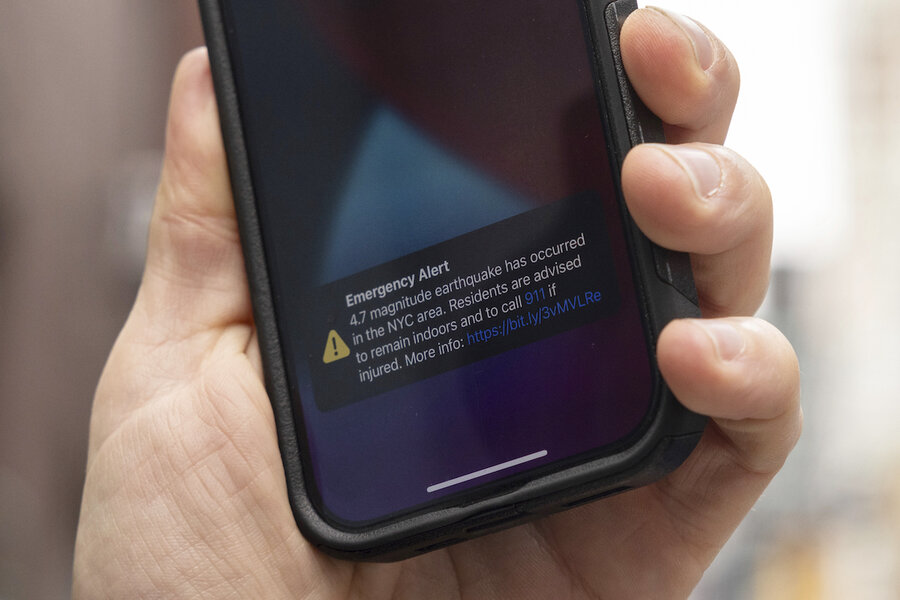Rare East Coast earthquake rocks New York City. How big was it?
Loading...
| New York
An earthquake shook the densely populated New York City metropolitan area the morning of April 5, the U.S. Geological Survey said, with residents across the Northeast reporting rumbling in a region where people are unaccustomed to feeling the ground move.
The agency reported a quake at 10:23 a.m. with a preliminary magnitude of 4.8, centered near Lebanon, New Jersey, or about 45 miles west of New York City and 50 miles north of Philadelphia. U.S.G.S. figures indicated that the quake might have been felt by more than 42 million people.
New York City’s emergency notification system said in a social media post more than 30 minutes after the quake that it had no reports of damage or injuries in the city. The Fire Department of New York said on social media about an hour after the quake that it was “responding to calls and evaluating structural stability” but that there are “no major incidents at this time.”
Amtrak said it was inspecting its tracks and had speed restrictions in place throughout the busy Northeast Corridor. New Jersey Transit posted on X that its train system was subject to delays caused by bridge inspections. The Philadelphia area’s PATCO rail line suspended service out of what it said was “an abundance of caution.”
People in Baltimore, Philadelphia, Connecticut, and other areas of the Northeast reported shaking. Tremors lasting for several seconds were felt over 200 miles away near the Massachusetts-New Hampshire border. In midtown Manhattan, traffic grew louder as motorists blared their horns on shuddering streets. Some Brooklyn residents heard a boom and their building shaking.
In New York City’s Astoria neighborhood, Cassondra Kurtz was giving her Chihuahua, Chiki, a cocoa-butter rubdown and recording the moment on video, when her apartment started shaking hard enough that a large mirror banged audibly against a wall.
Ms. Kurtz assumed at first it was a big truck going by. The video captured her looking around, perplexed. Chiki, however, “was completely unbothered.”
Attorney Finn Dusenbery was in a law office in midtown Manhattan. “The building shook and I thought that the ceiling above me was going to collapse,” Mr. Dusenbery said. “I did think that maybe the building was going to fall down for a second, and I wanted to get out of the building when I felt that.”
Solomon Byron was sitting on a park bench in Manhattan’s East Village. “I felt this vibration, and I was just like, where is that vibration coming from,” Mr. Byron said. “There’s no trains nowhere close by here or anything like that.” Mr. Byron said he didn’t realize there had been an earthquake until he got the alert on his cellphone.
At U.N. headquarters in New York, the shaking interrupted the chief executive of Save The Children, Janti Soeripto, as she briefed an emergency Security Council session on the threat of famine in Gaza and the Israeli drone strikes that killed aid workers there. In short order, diplomats’ phones blared with earthquake alerts.
The White House said in a statement that President Joe Biden had been briefed on the earthquake and was “in touch with federal, state, and local officials as we learn more.”
New York Gov. Kathy Hochul posted on X that the quake was felt throughout the state. “My team is assessing impacts and any damage that may have occurred, and we will update the public throughout the day,” Ms. Hochul said.
Philadelphia police asked people not to call 911 about seismic activity unless they were reporting an emergency. Pennsylvania Gov. Josh Shapiro said state officials were monitoring the situation. A spokesperson for Connecticut Gov. Ned Lamont was unaware of any reports of damage in that state.
The shaking stirred memories of the Aug. 23, 2011, earthquake that jolted tens of millions of people from Georgia to Canada. Registering magnitude 5.8, it was the strongest quake to hit the East Coast since World War II. The epicenter was in Virginia.
That earthquake left cracks in the Washington Monument, spurred the evacuation of the White House and Capitol, and rattled New Yorkers three weeks before the 10th anniversary of the Sept. 11 terror attacks.
Earthquakes are less common on this side of the United States because the East Coast does not lie on a boundary of tectonic plates. But East Coast quakes can still pack a punch – its rocks are better at spreading earthquake energy across far distances.
“If we had the same magnitude quake in California, it probably wouldn’t be felt nearly as far away,” said U.S.G.S. geophysicist Paul Caruso.
This story was reported by The Associated Press.





